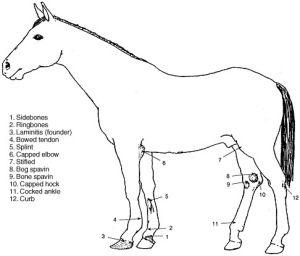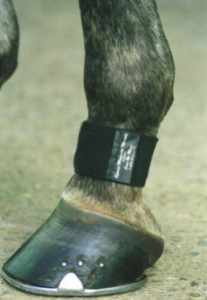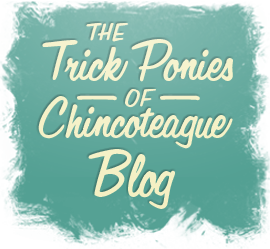Posts Tagged ‘supplement
Maintaining Ringbone: Minnow gets Injected with Ethyl Alcohol
Minnow was diagnosed with high ringbone back in 2008, and he’s been retired from all riding and competition since then. He’s lived pretty comfortably for many years, but this year he has been noticeably more sore. So in an effort to make him more comfortable for years to come I’ve been trying lots of options to help him be more pain free.
Our previous attempts to help Minnow can be read about here:
Maintaining Ringbone: Minnow’s Trip to New Bolton
Maintaining Ringbone: Minnow tries Ground Control Shoes
Since then we also began giving Minnow Pentosan injections because we had heard great things about this drug from some of our friends, in helping horses with arthritis. There really wasn’t any noticeable difference when Minnow was given Pentosan, so it wasn’t going to be a long term benefit to him.

We also tried giving Minnow Equioxx, which did help with his pain some, but the most helpful by far was giving Minnow bute along with a Fast track supplement to help protect the lining in his stomach.
While bute did help make Minnow more comfortable I still wanted to do all that I could to help him be more pain free, and bute is never a great long-term pain medication just because of the harm it can do to the intestines. So with the help of our vet we made another appointment for Minnow at New Bolton to have him injected with Ethyl Alcohol into his pastern joint with one of the renowned vet’s there.

The goal with the injection was to destroy the remaining cartilage in the joint allowing the joint to fuse as it has been trying to do naturally for the past several years. With this injection there is no guarantee it will work, and likely no results would even been seen for many months as it takes time for the joint to fuse. But there really is no down side to this procedure other than the risk of infection due to inserting the needle. Minnow should not be any more painful than he already is. So with fingers crossed we took Minnow back to New Bolton to have him injected.

Using X-rays, the vet was able to put the needle into the right space in Minnow’s joint to inject the alcohol (which was a bit difficult because his joint is already pretty deteriorated).

After one day we miraculously already saw improvement in Minnow. For the past 2 weeks he’s been “resting” in his stall and the small turnout paddock attached to his stall.
Here’s a video of Minnow BEFORE the injection:
Minnow a week AFTER the injection:
While Minnow is significantly improved, the hope is that his joint will continue to fuse over time and eventually he could be possibly even be pain free. He is so much more comfortable already that we have taken him off all of the pain meds and this week he gets to go out in the pasture with his buddies again.
While this procedure is never recommended for horses that will be ridden (Minnow will never be ridden again), Minnow met a lot of the criteria to make this procedure successful for him. Time will continue to tell how beneficial it will be to him.
Minnow is very special to me, and I will continue to do everything I can to make him comfortable and happy!
Maintaining Ringbone
 Lately I’ve been doing a lot of research into ringbone, because that is what Chincoteague Minnow was diagnosed with in 2008, and is the reason he was retired from competition and riding in general.
Lately I’ve been doing a lot of research into ringbone, because that is what Chincoteague Minnow was diagnosed with in 2008, and is the reason he was retired from competition and riding in general.
For anyone that doesn’t know, Ringbone is a bone growth in the pastern or coffin joint of a horse. In severe cases, the growth can encircle the bones, giving ringbone its name. Essentially ringbone is a form of equine arthritis. There are several reasons why horses can develop ringbone, I’m fairly certain that Minnow developed it due to poor confirmation (he has fairly upright pasterns) and the fact that for 4 years I competed him in a speed sport, Mounted Games. Although Minnow did develop ringbone in his left front, which is sort of contradictory to our sport, because the majority of the time we always make right hand turns – putting most of the strain on the right front leg. So I think that even though Minnow was involved with a physically demanding sport, he likely would have developed ringbone either way.
Some horses can continue to be ridden with proper maintenance, and there are several treatment options, although none can cure ringbone. One such option is joint injections, which I did try on Minnow at the suggestion of several vets. The pastern joint can be injected directly, typically with a form of corticosteroid and hyaluronic acid. For several months Minnow was on stall rest, and although I did see improvement it was never enough to continue riding him like I had hoped.
Personally I didn’t think it was right to continue to ride Minnow (by drugging him up) simply for my enjoyment. So now the only “maintenance” Minnow gets is proper barefoot shoeing and the occasional dose of bute (sort of like aspirin for horses) if he’s going to be doing something a little more strenuous like performing with me.
But as Minnow gets older (he turns 17 this year) I’ve begun to wonder if I’m doing enough to alleviate his pain? But at the same time I don’t want to dose him like crazy with supplements that he really doesn’t need. I’m sort of torn in both directions. He’s a hearty pony that was born wild, maybe less is better? I also read somewhere that light exercise is better for ringbone than letting the horse stand in one area a lot. Minnow is turned out daily, but maybe he needs more, perhaps I should be taking him on walking trail rides once a week or more?
So as I contemplate and research what is best for him I’m posting this question to all of my readers (or passerby’s) of this blog….Any Suggestions? Perhaps you’ve had/know a horse with ringbone…has anything worked for them?
As soon as I figure out this Ringbone dilemma I’ll have to move onto Equine Cushings – as my retired Dressage horse, Niatross, has been diagnoised with this illness. He’s not the first experience I’ve had with cushings though, my childhood pony, Oopsie Daisy, also had cushings in his later years.



